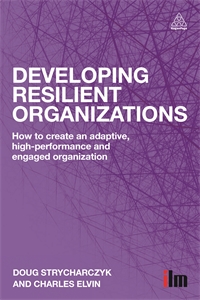What is resilience and what does it look like in an organizational context?

Co-author Doug Strycharczyk discusses how organizations can remain resilient in the face of adversity.
 1. What motivated you to write this book?
1. What motivated you to write this book?
The trigger lay in the work we have been doing with a wide range of organisations during the 2008 recession. A lot of organizations blamed their problems and challenges on the cause of the recession – the failure of the banking and finance system. It is a factor for many organizations but the issues they were talking about weren’t about what had caused the recession. There were two themes emerging –
- The inability of many organizations to be agile and responsive to what was happening. Those that were, have emerged stronger and have grown.
- The other was a big change in the way employers needed to engage with staff – both in terms of needing people to operate more flexibly and at a high level of performance without being able to promise traditional security as well as a new mindset from large swathes of young people entering the job market. They too didn’t expect a “job for life” and had a much more pragmatic attitude to their careers and life journeys.
Yet very few employers properly understood this and were dealing with their changes in traditional ways that weren’t going to work in the future.
Out of this there has emerged a number of important issues – resilient/mental toughness and trust - being the two of the most important, but there are others. Another gaining in importance globally is that employers must become engaged in the development of young people before they arrive on their doorstep – providing work experience is a must. Young people are often not work ready – but employers cannot stand back and moan about it if they don’t get involved.
2. What is resilience and what does it look like in an organizational context?
Resilience is the capacity to pick yourself up and keep going after an adverse event. But simply gritting your teeth is not enough. There is a wider concept which embraces resilience which is more important. Mental toughness includes the notion that you see change and setback as an opportunity rather than a threat. And that individuals and organization have the confidence in their ability to respond in this way.
So, in an organizational context, success and achieving it with a positive frame of mind is about can do, never showing that you are beaten, being clear about what success looks like and going for it, accepting that there will be problems but that is part of your learning (it’s not a reason to stop), and then having the confidence to do all of that and to sell that everyone that matters.
It’s not difficult to translate that into a set of organisational competencies.
3. Why does it matter now?
We are into a new era of change. Change happens blindingly quickly and that’s the new norm. You can’t talk about whether you like change or you welcome change – organisations and individuals have to be up for it.
4. Is it something that can be measured?
Definitely. It requires a clear understanding of what it is – which has now emerged and a well-designed measure which is properly validated – which we now have in the MTQ48. People the world over are only just beginning to realise how far sighted some of Professor Peter Cloughs work really. Because it is so simple and so accessible the response has often been “Its can't be that easy to understand”. It is – the hard part as always is doing something about it. However, you can't do something about building confidence grit and resilience if you don’t know where you are starting.
5. What is the 4 Cs model of mental toughness?
It's built on the work of people like Kobasa who developed a model of Hardiness in the 1980s.
Research carried out under the direction of Professor Peter Clough of Manchester Metropitan University has identified the 4 key components of Mental Toughness. These are called the 4 Cs. This research has now been independently validated through studies in Canada, Italy as well as the UK.
Mental Toughness Scale | What this means … what does MTQ48 assess |
CONTROL | Life Control – I really believe I can do it |
Emotional Control – I can manage my emotions and the emotions of others | |
COMMITMENT | Goal Setting – I promise to do it – I like working to goals |
Achieving – I’ll do what it takes to keep my promises and achieve my goals | |
CHALLENGE | Risk Taking – I will push myself – I am driven to succeed |
Learning from Experience – even setbacks are opportunities for learning | |
CONFIDENCE | In Abilities – I believe I have the ability to do it – or can acquire the ability |
Interpersonal Confidence – I can influence others – I can stand my ground if needed |
Life Control and Commitment equate to what is normally understood by the term Resilience. Mental toughness embraces this but adds some more elements which interplay with resilience. It is important to have the bigger picture.
6. What kind of relationship might we see developing between an employer and an employee in the 21st century?
Leadership and understanding motivation will be more and more important from the employers perspective. The challenge will be to engage with a plethora of different types of staff – FT, PT, contract workers, temporary workers, projects workers, associates etc. who need to perform at the highest level and show a good level of commitment to the organization.
Staff will have different levels of skills, knowledge and expectations. It's already common to find new entrants into an organization to have better IT skills than existing staff and managers, and have much better skills at learning and getting information. Most importantly, most (but not all) will, in Maslow terms, be much less concerned with attending to basic needs but will want satisfaction at the higher order level. So the employers who sees the relationship between the organization and its staff as a financially-based arrangement is unlikely to keep the best staff. Engagement is going to be an important term in the future – and that is why trust is an important issue and growing issue today.





